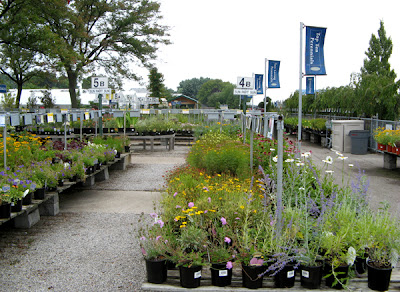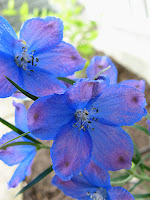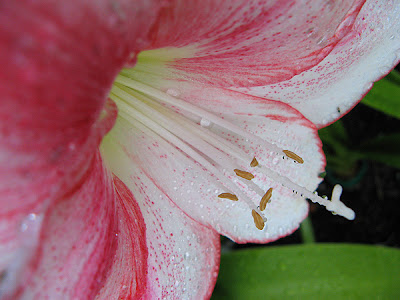Back on Father's Day, Dad asked me if I would like to go on a bus trip with him and Mom. The YWCA in Van Wert was taking a trip to the Sandusky, Ohio area, with stops at an herb farm, winery, city gardens, a carousel museum, and a garden center. Oh, and there was ice cream involved. Dad's treat. Count me in!
 Yesterday, we boarded an Executive Coach bus between 6:30 and 7:00 a.m. and headed northeast. We stopped at a McDonald's in Findlay for breakfast, where I had an Egg McMuffin, which is one of only two things I'll eat there. This is one thing that McDonald's gets right besides their fries.
Yesterday, we boarded an Executive Coach bus between 6:30 and 7:00 a.m. and headed northeast. We stopped at a McDonald's in Findlay for breakfast, where I had an Egg McMuffin, which is one of only two things I'll eat there. This is one thing that McDonald's gets right besides their fries.
 Our first visit of the day was to Mulberry Creek Herb Farm. What a lovely place out in the country near Huron, Ohio. The owner gave us a very informative tour of his gardens there (which are all organic) and imparted lots of information we can really use.
Our first visit of the day was to Mulberry Creek Herb Farm. What a lovely place out in the country near Huron, Ohio. The owner gave us a very informative tour of his gardens there (which are all organic) and imparted lots of information we can really use.
 I was on a quest for 'Kent Beauty' oregano and was disappointed that yet another place I've looked didn't have it. Mark showed me a couple of other rotundifolia oreganos that he'd recommend but didn't have for sale either, but they're all very pretty and it's late in the season so I'm really not surprised there weren't any left.
I was on a quest for 'Kent Beauty' oregano and was disappointed that yet another place I've looked didn't have it. Mark showed me a couple of other rotundifolia oreganos that he'd recommend but didn't have for sale either, but they're all very pretty and it's late in the season so I'm really not surprised there weren't any left.
 Mark informed us that if we purchased one of any plant he had for sale, we could have a second one for free. Well, who can resist a deal like that? I tried to show restraint though, and purchased Large Yellow Foxglove (Digitalis grandiflora), which is a perennial foxglove (versus the traditional biennial variety). I wanted to buy some hard-neck garlic (Allium sativum var. ophioscorodon 'Music'), but didn't see any, so I asked about it. It was curing out, but I was able to purchase two of them for planting in October.
Mark informed us that if we purchased one of any plant he had for sale, we could have a second one for free. Well, who can resist a deal like that? I tried to show restraint though, and purchased Large Yellow Foxglove (Digitalis grandiflora), which is a perennial foxglove (versus the traditional biennial variety). I wanted to buy some hard-neck garlic (Allium sativum var. ophioscorodon 'Music'), but didn't see any, so I asked about it. It was curing out, but I was able to purchase two of them for planting in October.
 Mulberry Creek Farms features many, many miniatures and there were charming fairy gardens planted as well as a large train landscape that had scenes peppered with miniatures that were amazingly similar to their full-sized counterparts.
Mulberry Creek Farms features many, many miniatures and there were charming fairy gardens planted as well as a large train landscape that had scenes peppered with miniatures that were amazingly similar to their full-sized counterparts.
After being treated to black cherry ice cream with chocolate morsels and spiced with cardamom (Yum!), we got back on the bus and headed for Sandusky.
We stopped for lunch at The Angry Trout, which overlooks Sandusky Bay, where I had salad, meat loaf, mashed potatoes, a hard roll and carrot cake for dessert.

 Next stop was Firelands Winery, where we viewed a video presentation about the history and business of growing grapes and winemaking in the microclimate here around Lake Erie. The grapes are grown on Isle St. George, which has a unique growing situation:
Next stop was Firelands Winery, where we viewed a video presentation about the history and business of growing grapes and winemaking in the microclimate here around Lake Erie. The grapes are grown on Isle St. George, which has a unique growing situation:
Only a mile and a half wide and even less in length, Isle St. George is crisscrossed by a network of underground limestone caves. As the warm lake water circulates through these caves, ground frost is delayed until late fall. When the fall air becomes cooler, the warm lake water heats the surrounding air and land. Before winter sets in, the lake islands enjoy a 200-day frost-free growing season, remarkable and unusual for this climate. On North Bass Island, the grapes are harvested as much as six weeks after harvesting ends on the mainland. The United States Government has recognized the area's unique climate, soil, topographic and historic conditions that produce distinctive characteristics in the grapes grown here, and has established the area from the Bass Island and the southern shore of Lake Erie - stretching from Toledo into New York State - as the Lake Erie Appellation of Origin. When a Lake Erie designation is indicated on the label of a wine, it means that the grapes used in the wine came from this specific viticulture area.¹
 After tasting five of the wines they offer at Firelands, we took a tour of the facilities and took time to shop their gift shop and make wine purchases. I didn't buy any bottles of wine, although the ice wine in the slender blue bottles tempted me ($29.95 stopped me).
After tasting five of the wines they offer at Firelands, we took a tour of the facilities and took time to shop their gift shop and make wine purchases. I didn't buy any bottles of wine, although the ice wine in the slender blue bottles tempted me ($29.95 stopped me).
 There were some old-fashioned blown glass ornaments I'd seen in one of their display cases upstairs but I didn't see any for sale in the gift shop. I wanted one, because most of the ornaments on our Christmas tree are this type. I asked about them and was told they were out of stock. Would they consider selling one from the display case? The sales associate quietly said, "Sure, let's go pick one out." I always say that it doesn't hurt to ask, and I now have a blown glass cluster of grapes for our Christmas tree, and this will be a nice memento of our visit to the winery.
There were some old-fashioned blown glass ornaments I'd seen in one of their display cases upstairs but I didn't see any for sale in the gift shop. I wanted one, because most of the ornaments on our Christmas tree are this type. I asked about them and was told they were out of stock. Would they consider selling one from the display case? The sales associate quietly said, "Sure, let's go pick one out." I always say that it doesn't hurt to ask, and I now have a blown glass cluster of grapes for our Christmas tree, and this will be a nice memento of our visit to the winery.

We traveled to downtown Sandusky, where we were supposed to leave the bus and take a walking tour of the city gardens, but the weather had other plans. Due to the rain, we stayed in the bus and an employee of the city parks department narrated our mobile tour of the beautiful gardens.
 Adjacent to the downtown gardens was the Carousel Museum, housed in the former Post Office. We were given an informative presentation about some of the history of carousel horses and got to see an artist painting a horse that would later be won by someone who had purchased a lottery ticket for it.
Adjacent to the downtown gardens was the Carousel Museum, housed in the former Post Office. We were given an informative presentation about some of the history of carousel horses and got to see an artist painting a horse that would later be won by someone who had purchased a lottery ticket for it.
Then we took a ride! I can't remember the last time I rode on a carousel, and it's amazing how such a simple thing can be so much fun.

I picked up another blown glass ornament here, of a carousel horse.
 Corso's in Sandusky was our next stop and it was somewhat of a feeding frenzy. I mean, you know what happens when you dump a bunch of gardeners off in a large nursery having a sale and offering you a free plant, don't you? Here's what happened to me:
Corso's in Sandusky was our next stop and it was somewhat of a feeding frenzy. I mean, you know what happens when you dump a bunch of gardeners off in a large nursery having a sale and offering you a free plant, don't you? Here's what happened to me:


Coleus 'Fishnet Stockings', Viola cornuta 'Columbine', Sedum makinoi 'Ogon'
Time to head home, but not before stopping at Toft's Dairy for ice cream. For two dollars, I got a pint of Caramel Mountain Tracks which Toft's describes as "Caramel Turtles climbing mountains of toffee ice cream flowing with streams of Mackinac Fudge and praline pecans." Oh myyyyyyyy... I couldn't finish it all so Mom did me the favor.

 Though tiring, it was a wonderful day with a great group of people, not the least of which were two that mean more than the world to me. Love you, Mom and Dad!
Though tiring, it was a wonderful day with a great group of people, not the least of which were two that mean more than the world to me. Love you, Mom and Dad!
¹"Our Process", Firelands Winery website.

















































